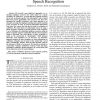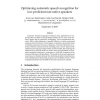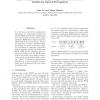249 search results - page 22 / 50 » Continuous speech recognition with a TF-IDF acoustic model |
TASLP
2002
13 years 7 months ago
2002
Abstract--We describe some high-level approaches to estimating confidence scores for the words output by a speech recognizer. By "high-level" we mean that the proposed me...
EJASMP
2010
13 years 2 months ago
2010
Computer Assisted Language Learning (CALL) applications for improving the oral skills of low-proficient learners have to cope with nonnative speech that is particularly challengin...
CSL
2007
Springer
13 years 7 months ago
2007
Springer
Hidden Markov Models (HMMs) are the most commonly used acoustic model for speech recognition. In HMMs, the probability of successive observations is assumed independent given the ...
ICASSP
2009
IEEE
14 years 2 months ago
2009
IEEE
This paper presents a novel approach for those applications where vocabulary is defined by a set of acoustic samples. In this approach, the acoustic samples are used as reference...
NAACL
2003
13 years 8 months ago
2003
It is well known that frame independence assumption is a fundamental limitation of current HMM based speech recognition systems. By treating each speech frame independently, HMMs ...



